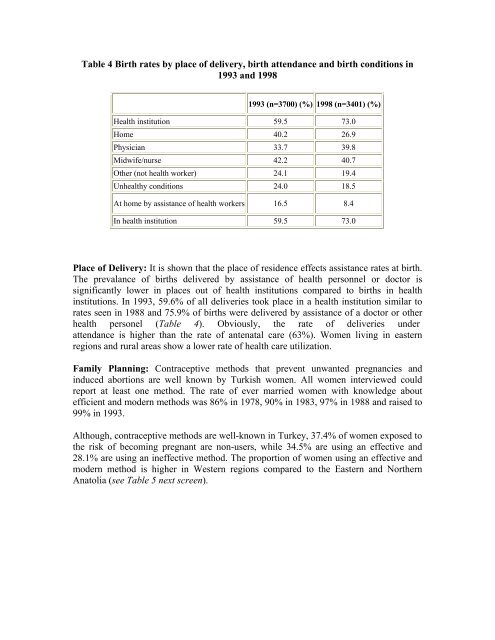Mother Health in Turkey - Middle East Journal of Family Medicine
Mother Health in Turkey - Middle East Journal of Family Medicine
Mother Health in Turkey - Middle East Journal of Family Medicine
Create successful ePaper yourself
Turn your PDF publications into a flip-book with our unique Google optimized e-Paper software.
Table 4 Birth rates by place <strong>of</strong> delivery, birth attendance and birth conditions <strong>in</strong><br />
1993 and 1998<br />
1993 (n=3700) (%) 1998 (n=3401) (%)<br />
<strong>Health</strong> <strong>in</strong>stitution 59.5 73.0<br />
Home 40.2 26.9<br />
Physician 33.7 39.8<br />
Midwife/nurse 42.2 40.7<br />
Other (not health worker) 24.1 19.4<br />
Unhealthy conditions 24.0 18.5<br />
At home by assistance <strong>of</strong> health workers 16.5 8.4<br />
In health <strong>in</strong>stitution 59.5 73.0<br />
Place <strong>of</strong> Delivery: It is shown that the place <strong>of</strong> residence effects assistance rates at birth.<br />
The prevalance <strong>of</strong> births delivered by assistance <strong>of</strong> health personnel or doctor is<br />
significantly lower <strong>in</strong> places out <strong>of</strong> health <strong>in</strong>stitutions compared to births <strong>in</strong> health<br />
<strong>in</strong>stitutions. In 1993, 59.6% <strong>of</strong> all deliveries took place <strong>in</strong> a health <strong>in</strong>stitution similar to<br />
rates seen <strong>in</strong> 1988 and 75.9% <strong>of</strong> births were delivered by assistance <strong>of</strong> a doctor or other<br />
health personel (Table 4). Obviously, the rate <strong>of</strong> deliveries under<br />
attendance is higher than the rate <strong>of</strong> antenatal care (63%). Women liv<strong>in</strong>g <strong>in</strong> eastern<br />
regions and rural areas show a lower rate <strong>of</strong> health care utilization.<br />
<strong>Family</strong> Plann<strong>in</strong>g: Contraceptive methods that prevent unwanted pregnancies and<br />
<strong>in</strong>duced abortions are well known by Turkish women. All women <strong>in</strong>terviewed could<br />
report at least one method. The rate <strong>of</strong> ever married women with knowledge about<br />
efficient and modern methods was 86% <strong>in</strong> 1978, 90% <strong>in</strong> 1983, 97% <strong>in</strong> 1988 and raised to<br />
99% <strong>in</strong> 1993.<br />
Although, contraceptive methods are well-known <strong>in</strong> <strong>Turkey</strong>, 37.4% <strong>of</strong> women exposed to<br />
the risk <strong>of</strong> becom<strong>in</strong>g pregnant are non-users, while 34.5% are us<strong>in</strong>g an effective and<br />
28.1% are us<strong>in</strong>g an <strong>in</strong>effective method. The proportion <strong>of</strong> women us<strong>in</strong>g an effective and<br />
modern method is higher <strong>in</strong> Western regions compared to the <strong>East</strong>ern and Northern<br />
Anatolia (see Table 5 next screen).
















